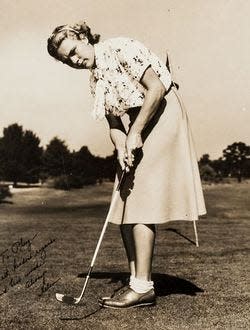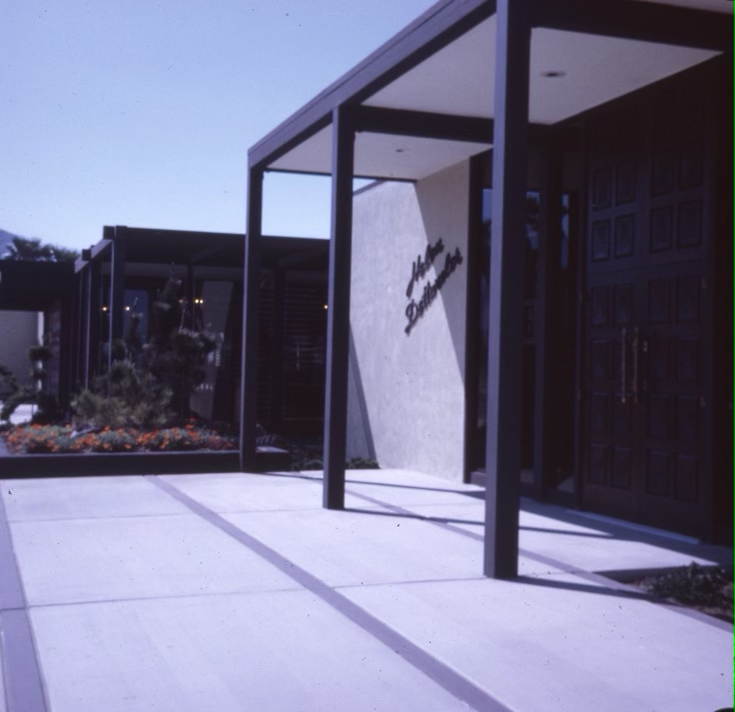History: From golf to B-17s, stylish 'girl' Helen Dettweiler easily kept up with 'the men'
- Oops!Something went wrong.Please try again later.

“Girl Will Give Sports Report” read the headline in the Minneapolis Star Tribune in September 1938. That “girl” was 23-year-old Helen Dettweiler, the “first and so far the only woman radio baseball reporter to do the play-by-play broadcasts.”
The report described the highly accomplished athlete as a “blonde, native of Washington, D.C.” who “has taken over the baseball broadcasts on 50 stations on a roving assignment which will eventually take her to 69 stations. … Miss Dettweiler is an outstanding sports champion. She has demonstrated championship class in nearly every form of women’s sports.”
Dettweiler’s sheer gumption was demonstrated by how she got the gig: “Having played baseball since she was 5 years old, not only on the back lot, but also on school and college teams, Miss Dettweiler hit on the idea during a golf game with Clark Griffith, president of the Washington Senators. She expressed her wish to become a woman baseball announcer. He thought the idea had merit and put her in touch with radio interests.”
The country was fascinated with the female announcer and her habiliments and hairstyle. “Mere woman has invaded man’s last outpost in radio. And the woman in this case is Helen Dettweiler, blond and young. She’s radio’s first ‘big-time’ femme sports announcer. …Miss Dettweiler wears her hair neatly waved and she might easily double as a model for what the particular girl wears for sports.”
But Dettweiler could more than keep up with men, even while wearing a skirt. She would become famous, not for baseball or broadcasting, but for golf.
It started with a challenge from her brother Bill, an expert golfer. As the Philadelphia Inquirer explained: “As a youngster, blonde Helen was more interested in baseball. She played it too – hardball, not softball. One day Bill bet her a chocolate soda she couldn’t hit a golf ball four straight times. She stepped up confidently and hit the first – then wiffed three straight. That early frustration in the ‘humblin game’ so riled Helen that she rushed off to Al Treder, a local pro, and pleaded: ‘Make me hit the ball every time I aim at it.’” Soon she was hitting it every time she tried. She won the 1939 Women’s Western Open and turned pro.
But World War II was on. She joined the Women Airforce Service Pilots, WASP, administered by Jacqueline Cochran, and was one of 17 women selected to pilot the Boeing B-17 Flying Fortress, logging an impressive 750 hours in the air. Attitudes toward women had been changed by the war. Initially welcomed to the workforce as men were called overseas, they soon were competing in a way society thought unattractive.
Rhonda Glenn, writing for the United States Golf Association noted, “The women pilots were somewhat demeaned, but it was in the context of the times and they soon earned grudging respect.”
Glenn quotes Major Harry Shilling, Air Corps director of maintenance, as saying of Dettweiler and Cochran: “Quite a big job for two delicate dishes of femininity. Perhaps they should take some of our supermen for a ride and show them how to get off the ground.”
Male pilots who returned from the war aced out women for flying jobs in private industry. According to Glenn, women were forced out “through a public relations campaign in Congress and the press.” Glenn quoted one WASP: “Just six months earlier it had been heroic to do a man’s job, but by mid-1944, it was considered unpatriotic.”
When Cochran wanted to write a history of the disbanded WASP, she invited Dettweiler to the desert to help. Cochran and her husband, Floyd Odlum, owned an expansive ranch in Indio. Tired of driving all the way to Palm Springs to play golf, Cochran and Odlum decided to build a few holes in the backyard. Dettweiler suggested an entire course instead.
Dettweiler wanted an 18-hole course, with the novel idea of homesites around it, looking out on the thousand acres of citrus and palm trees. Odlum was skeptical that golf in the desert would ever be popular. The couple asked Dettweiler to design just nine holes, missing a major opportunity. Her design was still another first for women.
The change in attitude about women in sport was reflected in Hollywood. “Pat and Mike” starring Katharine Hepburn and Spencer Tracy reflected that change. Interestingly, Dettweiler appeared as herself in the film with Betty Hicks, Beverly Hanson, Alice Marble, Gussie Moran and female athletic phenom Babe Didrikson Zaharias.
The pioneering picture promoted these athletes as competent and comparable to men. It also managed to charmingly school the audience about women’s equality despite having an opening scene that tackled the important question of whether women can wear slacks in polite company.
Glenn wrote that Dettweiler was “vivacious yet possessing a soft charm, was a popular player, and Wilson Sporting Goods sought her for their women’s staff to give exhibitions and promote the sale of clubs.” Dettweiler co-founded the Women’s Professional Golf Association, and after that fell apart, she was one of the 13 founders of the Ladies Professional Golf Association in 1950.
A well-established expert, she became a teaching pro at Thunderbird Country Club in 1952, subsequently also teaching at Eldorado Country Club. When Tamarisk Country Club opened, they wanted to outshine the other clubs. Naturally, Tamarisk hired Ben Hogan, the best golfer in the world, as the pro.
Tamarisk had an exhibition match to inaugurate the course, inviting Jimmy Hines and Johnny Dawson from Thunderbird, George Howard from the O’Donnell Golf Club and filling out the foursome with a woman, Dettweiler.Dettweiler recalled there were lots of bets on the match, for big money. On the 18th hole, Dettweiler and Hogan were up by one. To even the match, Hogan missed his final putt on purpose so that no money would trade hands.
Dettweiler’s career concentrated on instruction; she was the first recipient of the LPGA’s Teacher of the Year award in 1958.
Dettweiler was active on the tour into the 1960s, and Glenn paid tribute to her remarkable career: “Few know of Dettweiler’s very real and essential role as a member of that greatest generation. Like most authentic heroes, she didn’t discuss her war exploits and would barely touch upon them when urged. Helen Dettweiler in her quiet way, a key figure in women’s golf, is largely forgotten. Her role in the war and the role of other women who flew planes for their country is just now being acknowledged. Those tributes are long overdue.”

After retiring from professional golf, Dettweiler opened an eponymous clothing store in Palm Desert selling not just stylish golf togs but fine fashions. The smart shop was denoted by a gorgeously scrolled sign across a William Cody-designed thoroughly modern building.
The 23-year-old “girl” who had begun broadcasting baseball humorously explained her pioneering spirit and willingness to compete in skirts or slacks: “I took up knitting when I was 9 years old. While I had scarlet fever, I made a wash cloth and then my mother had to burn it, so that ended my knitting.”
Tracy Conrad is president of the Palm Springs Historical Society. The Thanks for the Memories column appears Sundays in The Desert Sun. Write to her at pshstracy@gmail.com.
This article originally appeared on Palm Springs Desert Sun: Helen Dettweiler: pioneer woman pilot, golfer, broadcaster

